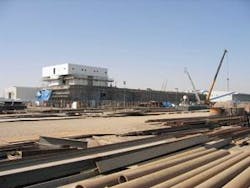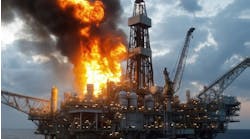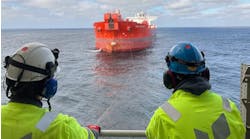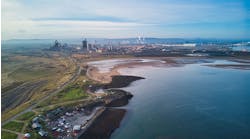Load-out of the main components for Turkmenistan’s first offshore extended well test should now be under way. By November, Petronas Carigali (Turkmenistan) expects all facilities to be in place for the three- to five-year campaign on block 1.
Production in this extended early phase will come through a jackup, which will offload to a turret-moored FSO. As usual in the land-locked Caspian, the main difficulties are logistical, i.e., bringing sub-assembled items in by land or via the Volga canal system. Main contractor SBM experienced added pressure from the ultra-fast track schedule, as the production concept was only agreed upon late last fall.
SBM won the contract for the engineering, procurement, fabrication, transportation, installation, and subsequent abandonment of the extended well test facilities last October. During tender phase investigations, the contractor realized that the schedule could only be met by placing main construction orders with yards outside the Caspian.
Size limits of pre-assembled units brought into the sea via either the northern or southern entry points and harsh environmental conditions in the Turkmen sector (i.e., a maximum wave height of 12.1 m) restricted options for the production test. Contractor and operator therefore reviewed a range of concepts, including monohull and catamaran FPSOs as well as a production jackup.
These were whittled down initially to a mobile offshore production unit (MOPU) jackup, equipped with full processing facilities to handle produced oil and gas, with storage on a converted FSO moored to a CALM buoy. SBM had picked several tankers as candidates for the FSO in the tender phase, but on closer inspection, none met the required size restrictions and oil storage capacity.
In mid November, therefore, contractor and operator instead commissioned a new-build FSO and dispensed with a CALM buoy altogether, replacing it with an external turret on the vessel. The latter would be stationed around 700 m from the MOPU, with the two systems connected by a 4-in. oil export line and a 2-in. fuel gas line.
The MOPU jackup is in a cruciform shape, which is being assembled from the hulls of two new barges. Three circular legs and Gusto MSC-designed jacking systems with a holding capacity of 3,000 tonnes each will support it. The two barge sections have been sized to respect shipping restrictions for entry through the southern route into the Caspian Sea. Once assembled, the barge will have main dimensions of around 100 x 60 m.
At the aft end, the MOPU will support a single surface tree. Main process facilities will comprise low and high-pressure separators, chemical injection, crude oil heaters, electrostatic treatment equipment, and an HP/LP flare. As there will be no gas export facilities during this phase of the development, all unused produced gas will have to be flared. The process train must also cope with the tendency of block 1 crude to turn waxy at temperatures below 38° C.
These facilities can sustain oil production at a rate of up to 15,000 b/d, produced water at up to 4,000 b/d, and gas flow of up to 36 MMcf/d. Two 2 x 1,000 kW main engines running on dual fuel, taking advantage of the produced gas, will generate power. There will be accommodation onboard for a crew of 20.
Block 1’s 60,000 bbl storage FSO will be 112 m long, 16.4 m wide, and 9.8 m deep, again representing the maximum size acceptable for the incoming southern passage. The vessel will be moored permanently via an external turret and six anchor lines. Six onboard tanks will store treated and stabilized crude, which will be offloaded periodically to a shuttle tanker in a tandem configuration, but with the possibility also for side-by-side offloading, as requested by the client.
Other main equipment on the FSO includes a segregated ballast system, crude oil washing, inert gas system, steam generator to maintain the crude above wax formation temperature, oil fiscal metering, dual-fuel power generation (2 x 750 kW), and a 3500-kW emergency generator. The vessel has accommodations for 18 crew.
SBM Offshore Group companies SBM, GustoMSC, and SBM-Imodco (SBMI) are jointly executing the project. GustoMSC is largely responsible for engineering and procurement, although the FSO engineering has been partly subcontracted to Vuyk Rotterdam. GustoMSC’s focus is the jackup, with SBMI designing the turret and subsea flowlines. SBM is the overall project manager, handling construction supervision, installation, commissioning, logistics, and subsequent operation of the EWT system.
To meet the ultra-quick timetable, the group fabricated as many of the components as possible in the same location, with trusted yards performing the work. For the jackup, GustoMSC built the legs in Antwerp and the jacking systems in The Netherlands. Lamprell in the UAE fabricated the MOPU barge. It completed the barge in May, followed shortly afterwards by installation of the jacking systems and outfitting of the MOPU.
Another UAE yard, MIS, should be close to completing the FSO and turret construction, while CKT and Al Masaood Bergum(AMB) have designed and fabricated the accommodation modules for both the MOPU and FSO. Hanover UK has managed fabrication of the pressure vessel, again at a yard in the UAE.
Securing all necessary approvals, transport, and operation permits is always problematic in this region, where the maritime borders are still in dispute. In this case, there was the added complication that all documents had to be generated in Russian and Turkic.
Among the first items to make their way over to the offshore location were the 36-in. conductors support piles. These were taken overland in six trucks directly from The Netherlands to Ashkabat in Turkmenistan. More recently, the completed MOPU legs and FSO anchors moved from northwest Europe to the Baltic Sea, then south through the Caspian’s northern entry point, the Volga river. If all goes as planned, the FSO and the two MOPU barge sections will load onto a Dockwise heavy transport vessel in early August. Once these have passed through the Black Sea, the various units will be towed in a floating condition through the southern Caspian route (Don-Volga canal).
In March, SBM commissioned a site survey to validate soil data in preparation for installation of the MOPU and the FSO anchors. On arrival at Baku, the two MOPU barge sections will be joined together, followed by installation of the legs and flare tower. Once at block 1, the MOPU will be positioned in respect to the pre-installed conductor and then jacked up to its final elevation. Transocean’sTrident 20 drilling jackup will then complete the well. Finally, the FSO will be anchored and the two subsea lines installed. •





